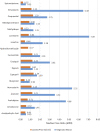Access to Essential Cardiovascular Medicines in Pakistan: A National Survey on the Availability, Price, and Affordability, Using WHO/HAI Methodology
- PMID: 33708114
- PMCID: PMC7941209
- DOI: 10.3389/fphar.2020.595008
Access to Essential Cardiovascular Medicines in Pakistan: A National Survey on the Availability, Price, and Affordability, Using WHO/HAI Methodology
Abstract
Objective: This national survey was aimed at measuring the access to cardiovascular disease (CVD) medicines in terms of their availability, price, and affordability in Pakistan. This was done by using the standard WHO/Health Action International (HAI) methodology. Methods: The price and availability data for 18 CVD medicines were collected from public sector hospitals (n = 40) and private sector retail pharmacies (n = 40) in eight cities of Pakistan. The outcome measures were availability (calculated as percentage of health facilities stocked with listed medicines), medicine price to the international reference price ratio (i.e., median price ratio (MPR)), and affordability (calculated as number of days' wages (NDWs) of the lowest paid unskilled government worker required to afford one-month treatment of a chronic disease). The affordability of standard treatment in Pakistan with four CVD drugs was compared with data from six other low and middle income countries (LMICs) using HAI database. Findings: The mean percent availability of CVD medicines was significantly low (p < 0.001) in the public sector as compared to the private sector, that is, 25.5% vs. 54.6% for originator brands (OBs) and 30.4% vs. 34.9% for lowest price generics (LPGs), respectively. For all OBs and LPGs, the inflation-adjusted mean MPR was 2.72 and 1, respectively. CVD medicines were found to be unaffordable with average NDWs of 6.4 and 2.2 for OBs and LPGs, respectively, that is, NDWs of more than 1. In international comparison with countries such as Sudan, Lebanon, Egypt, India, Afghanistan, and China, the affordability of standard treatment with selected CVD medicines (atenolol, amlodipine, captopril, and simvastatin) in Pakistan was found to be low. Overall, all four OBs and three out of four LPGs of selected CVD drugs were found unaffordable in Pakistan. Conclusion: This data indicated that the availability of selected CVD medicines was low in both public and private sector medicine outlets. Both OBs and LPGs were found unaffordable in the private sector, necessitating the redressal of pricing policies, structuring, and their implementation.
Keywords: access to medicines; cardiovascular drugs; essential medicines; medicines policy; non-communicable diseases.
Copyright © 2021 Saeed, Saeed, Saeed, Saleem, Yang, Chang, Jiang, Zhao, Saqlain, Ji, Aziz, Lambojon, Gillani, Hayat, Gul, Fang and Babar.
Conflict of interest statement
The authors declare that the research was conducted in the absence of any commercial or financial relationships that could be construed as a potential conflict of interest.
Figures
Similar articles
-
Impact of National Drug Pricing Policy 2018 on access to medicines in Lahore division, Pakistan: a pre-post survey study using WHO/HAI methodology.BMJ Open. 2020 Oct 8;10(10):e034720. doi: 10.1136/bmjopen-2019-034720. BMJ Open. 2020. PMID: 33033079 Free PMC article.
-
Evaluation of prices, availability and affordability of essential medicines in Lahore Division, Pakistan: A cross-sectional survey using WHO/HAI methodology.PLoS One. 2019 Apr 25;14(4):e0216122. doi: 10.1371/journal.pone.0216122. eCollection 2019. PLoS One. 2019. PMID: 31022276 Free PMC article.
-
Availability, pricing and affordability of essential medicines in Eastern Ethiopia: a comprehensive analysis using WHO/HAI methodology.J Pharm Policy Pract. 2021 Jul 5;14(1):57. doi: 10.1186/s40545-021-00339-2. J Pharm Policy Pract. 2021. PMID: 34225781 Free PMC article.
-
Health System Capacity and Access Barriers to Diagnosis and Treatment of CVD and Diabetes in Nepal.Glob Heart. 2021 May 18;16(1):38. doi: 10.5334/gh.927. Glob Heart. 2021. PMID: 34040951 Free PMC article.
-
Access to cardiovascular medicines in low- and middle-income countries: a mini review.Glob Health Res Policy. 2023 May 23;8(1):17. doi: 10.1186/s41256-023-00301-6. Glob Health Res Policy. 2023. PMID: 37221559 Free PMC article. Review.
Cited by
-
Availability of essential medicines in Pakistan-A comprehensive document analysis.PLoS One. 2021 Jul 9;16(7):e0253880. doi: 10.1371/journal.pone.0253880. eCollection 2021. PLoS One. 2021. PMID: 34242249 Free PMC article.
-
Mapping of familial hypercholesterolemia and dyslipidemias basic management infrastructure in Pakistan: a cross-sectional study.Lancet Reg Health Southeast Asia. 2023 Feb 20;12:100163. doi: 10.1016/j.lansea.2023.100163. eCollection 2023 May. Lancet Reg Health Southeast Asia. 2023. PMID: 37384054 Free PMC article.
-
A proposed analytical framework for qualitative evaluation of access to medicines from a health systems perspective.BMC Res Notes. 2024 Jun 7;17(1):159. doi: 10.1186/s13104-024-06764-1. BMC Res Notes. 2024. PMID: 38849915 Free PMC article.
-
Determinants of Adherence to Antihypertension Medications Among Patients at a Tertiary Care Hospital in Islamabad, Pakistan, 2019.Prev Chronic Dis. 2023 May 25;20:E42. doi: 10.5888/pcd20.220231. Prev Chronic Dis. 2023. PMID: 37229649 Free PMC article.
-
Factors associated with the availability and affordability of essential cardiovascular disease medicines in low- and middle-income countries: A systematic review.PLOS Glob Public Health. 2022 Mar 23;2(3):e0000072. doi: 10.1371/journal.pgph.0000072. eCollection 2022. PLOS Glob Public Health. 2022. PMID: 36962256 Free PMC article.
References
-
- Asif U., Saleem Z., Yousaf M., Saeed H., Hashmi F. K., Hassali M. A. (2018). Exploring the knowledge and attitude of medical and pharmacy students about generic medicine in Lahore, Pakistan. J. Generic Med. 14 (1), 22–28. 10.1177/1741134317748344 - DOI
LinkOut - more resources
Full Text Sources
Other Literature Sources


